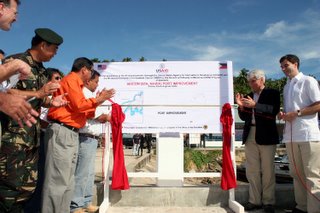Siocon town Mayor Ceasar Soriano, left, and US Chargé d'Affaires Paul Jones, right, led US and Filipino officials in the handover of a roll-on, roll-off port in Sta. Maria village. (Zamboanga Journal)
ZAMBOANGA DEL NORTE (Zamboanga Journal / 03 Jan) Siocon town Mayor Ceasar Soriano on Tuesday vowed to pursue a vigorous economic and development programs and urged citizens to work together and help build their future.
"There are so many things to do now. We will pursue a vigorous economic plans and undertake an aggressive development programs to put Siocon on top. We need the help of everybody to attain this goal," Soriano said.
He said the town's economic prospect is bright and more traders are putting up business in Siocon.
A Canadian mining firm, TVI Phils., Inc. is also operating in the town and has spent millions of dollars in investments the past years. Its executives said they planned to expand this year and it would provide more jobs to the locals.
US officials in November handed over almost half a million pesos worth of infrastructure projects in Siocon town as part of Washington's pledge to help develop the southern region.
One of the project was a roll-on, roll-off port in Sta. Maria village. The port construction was part of a mid-scale infrastructure project under the United States Agency for International Development (USAID).
One of the project was a roll-on, roll-off port in Sta. Maria village. The port construction was part of a mid-scale infrastructure project under the United States Agency for International Development (USAID).
Mindanao Economic Development Council chairman Jesus Dureza said President Gloria Arroyo ordered him to look into how the government can help fast track development projects not only in Siocon town, but also in other areas in the southern Philippines.
"We are working on many development projects and the President wants these projects to reach the most remote areas so it can benefit the poor people in the countryside. We have lined up more humanitarian projects in the southern Philippines," said Dureza.
Soriano said the new port will have a big impact not only on the local economy, but also to the province and others areas nearby.
"Our farmers will be able to bring and sell their goods to other areas. This will surely have a big impact on our economy and on the lives of everybody here," Soriano said.
Soriano said the United States Agency for International Development (USAID) and the Growth with Equity in Mindanao (GEM) donated five Internet-ready computer sets to the Siocon National High School.
He said the USAID and GEM pledged more computers. It was also the first time the town has access to the Internet. USAID also provided the school, which has about 2,000 students, with satellite Internet connection.
The USAID is carrying out a broad range of innovative programs in the country to promote investment and good governance to stimulate economic growth and job creation needed to reduce poverty, especially in conflict-affected areas in Mindanao.
Its programs include population and health and nutrition, economic development and governance, energy and environment, education, conflict reduction and humanitarian assistance.
Of the $9-million annual assistance of USAID to Philippines, Mindanao gets 60 percent of the fund.
USAID also launched its Computer Literacy and Internet Connection, or CLIC, program that is concentrated in the Muslim autonomous region. It has so far benefited about 125,000 students in more than 200 schools.
Through its solar-energy program, USAID had also brought electricity to remote islands in Tawi-Tawi province and nearby places.
Other USAID projects in Mindanao include the Alliance for Mindanao Off-Grid Renewable Energy (Amore), which helps provide power to small and rural villages.
And the Livelihood Enhancement and Peace (Leap) Program that help assist former fighters of the Moro National Liberation Front make the transition from guerrillas to productive farmers and fishermen. Leap has helped more than 24,000 former rebels in Mindanao.
The Philippines is the second largest recipient of U.S. foreign assistance in East Asia after Indonesia. US humanitarian projects to the Philippines averaged between $80 million to $90 million over the last several years and much of these are focused on the peace process in Mindanao.
President Arroyo has promised more aid to Siocon when she visited the town two years ago.

No comments:
Post a Comment